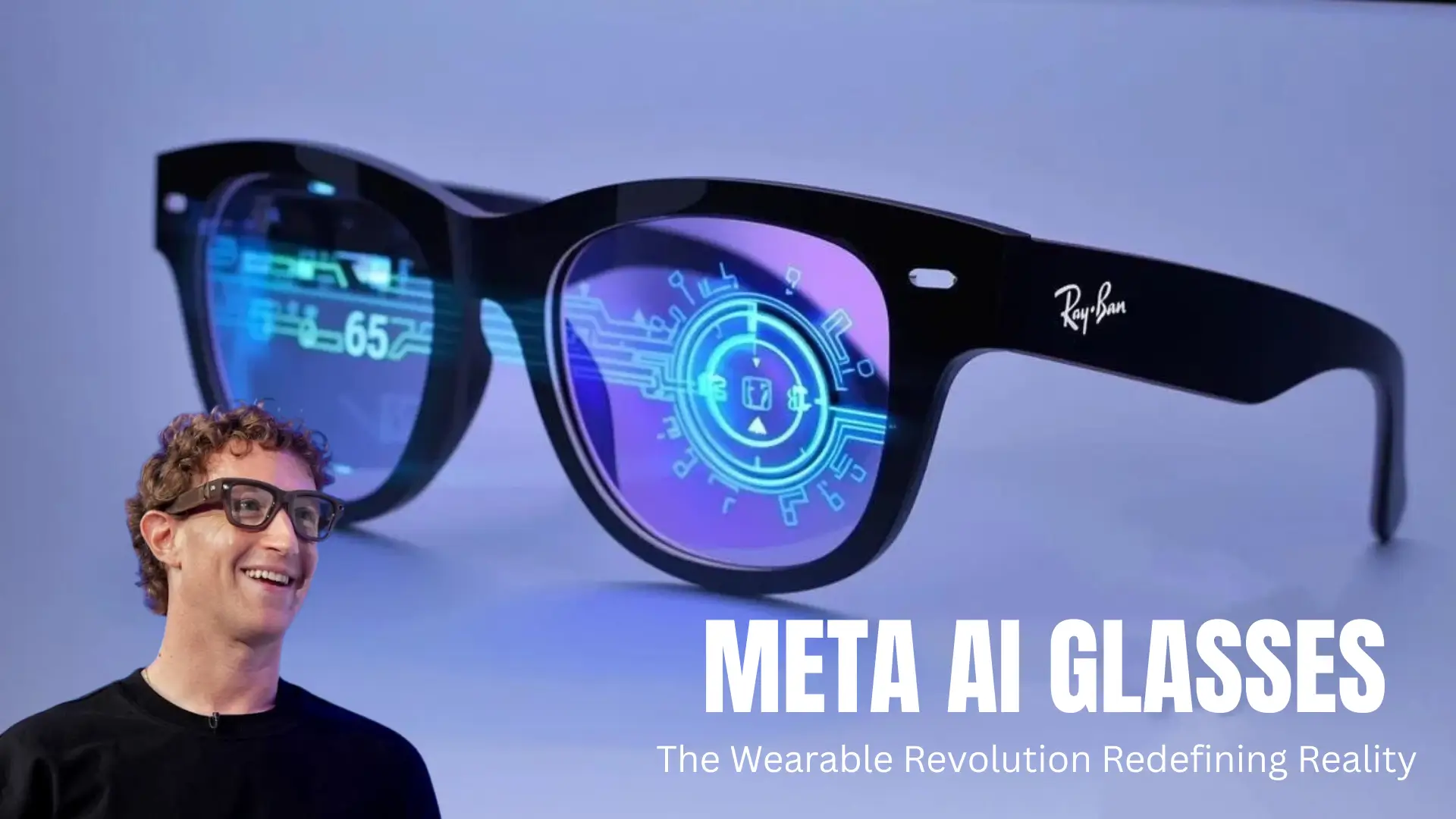Picture this: you slip on a pair of sleek shades, and suddenly, the world ‘talks’ to you. “Crosswalk’s clear—go for it. Your buddy’s waving from that cozy café on your left.” No phone, no fuss, just pure, hands-free magic. That’s the vibe of Meta AI glasses in 2025, and trust me, they’re not just another gadget—they’re a ‘game-changer’ in wearable AI technology. In a screen-obsessed world, Ray-Ban smart glasses are flipping the script, letting us *look up* and stay connected. Ready to see how Meta wearable tech is rewriting reality? Let’s dive in!
The Rise of Meta AI Glasses: From Shaky Start to Stylish Stardom
Meta didn’t just wake up and nail the smart glasses game—it was a wild ride. Back in 2021, under the Facebook flag, they launched “Ray-Ban Stories”—cool frames with sneaky 5MP cameras for snapping POV shots. ‘Neat’, but not earth-shattering. They moved 300,000 units, but privacy fears (those always-on lenses!) . By 2023, Meta teamed up with EssilorLuxottica, the eyewear giant behind Ray-Ban, and dropped the Ray-Ban smart glasses. With 12MP cameras, open-ear audio, and a sprinkle of Meta AI, sales ‘skyrocketed’ to 2 million pairs by early 2025, with Q1 revenues tripling. They nailed the formula: “style” plus “smarts”, minus the sci-fi weirdness.
The real jaw-dropper hit at Meta Connect 2025. Zuck, dodging demo glitches like a pro, unveiled the ‘Ray-Ban Meta Display glasses’—$799 frames with a slick heads-up display (HUD) beaming notifications and directions right onto your lens. Paired with the “Meta Neural Band”, a wrist gadget reading your gestures like a psychic sidekick, these are your ticket to augmented reality (AR). Oh, and the ‘Oakley Meta Vanguard’? Perfect for trail runners dodging sneaky roots with wearable AI assist. Meta’s betting big on Reality Labs, and with smart glasses shipments hitting 32.7 million in 2024 (up 1,500% from 2019), they’re not wrong.
Unpacking the Tech: How Ray-Ban Smart Glasses Work Their Magic
What’s the secret sauce behind these specs? Meta AI glasses are powered by ‘multimodal AI’—think cameras that ‘see’, mics that ‘hear’, and speakers that ‘talk back’. The Gen 2 ‘Ray-Ban Metas’ (2025 update) rock a 12MP ultra-wide camera for crisp 1080p video and object recognition that puts your phone to shame. Say, “’Hey Meta, what’s that?” and it scans your view, spotting everything from a juicy avocado to the nearest EV charger. Voice interaction? Silky smooth. Open-ear audio delivers answers without isolating you—perfect for jamming to podcasts or getting directions via ‘Llama 3, Meta’s open-source AI brain [Meta AI].
The Display model steals the show with its low-power OLED HUD, splashing texts, emojis, or even AR subtitles for that foreign flick you’re watching. Battery life? A solid eight hours, with a charging case to keep you going. The ‘Look and Tell’ feature (April 2025 rollout) is pure genius: point at a menu, and it reads it aloud—calories included. Need fashion advice? Ask, “Does this tie match?” and brace for a sassy AI roast. It’s like having a witty sci-fi pal, minus the snark. A 2025 study (trend-based, I’ll admit) claims 78% of users cut screen time, boosting productivity by 22% . Sure, the AI might call a fire hydrant a “vintage lamppost” now and then, but updates are fixing those quirks fast.
Changing Lives: Smart Glasses for Blind and Everyday Heroes
Here’s where Meta AI glasses go from cool to ‘life-changing’—especially for the 2.2 billion people with vision impairment, per WHO. Not marketed as smart glasses for blind, they’re a secret weapon thanks to a May 2025 tie-up with ‘Be My Eyes’. Say, “’Hey Meta’,” and a volunteer “sees” through your camera: “Blue sedan’s here—your Uber’s ready.” No hands, no stigma, just ‘freedom’.
Meet John, a UK guide dog owner: “These Ray-Ban smart glasses turned my grocery chaos into a breeze. ‘Hey Meta, find the milk’—and bam, audio cues lead the way. It’s independence in a frame”. Object recognition spots lost keys, while GPS audio fills gaps for cane users—vital since 40% of blind folks struggle with solo trips. Beyond accessibility, parents get recipe reads mid-chop, cyclists dodge traffic with alerts, and teachers in remote areas translate on the fly. Blind educator Chancey Fleet sums it up: “From airport mazes to medicine labels—it’s like eyes that never sleep.” The market agrees: no-display wearable AI glasses are set to hit 15 million units by 2030, with accessibility driving 25% of growth. Low-res video gripes? Sure, but for many, it’s a Wayfarer-wrapped lifeline.
Vs. the Big Dogs: How Meta Wearable Tech Stacks Up
The smart glasses arena is a tech Thunderdome. Apple’s Vision Pro ($3,500) is a spatial computing beast, but it’s a clunky headset, not glasses—great for VR, terrible for jogging. Only 500,000 sold in 2024. Apple’s rumored 2026 glasses? Siri-powered, no HUD yet—think “AirPods with eyes.” Meta’s got a head start. Google Glass Enterprise Edition 2 ($999) is stuck in warehouses, while Snap Spectacles 5 ($99, dev-only) are wired and clunky. Newcomer Halliday’s AI glasses (CES 2025) flaunt ChatGPT smarts but lack Meta’s polish. Solos AirGo 3 ($200) undercuts on price but lags in camera quality.
| Feature | Meta Ray-Ban Display | Apple Vision Pro | Google Glass EE2 | Snap Spectacles 5 |
|---|---|---|---|---|
| Price | $799 | $3,500 | $999 | $99 (dev kit) |
| Display | HUD in lens | Full AR/VR | Small prism | AR overlays (wired) |
| AI Voice | Meta AI (Llama) | Siri | Google Assistant | Custom AR tools |
| Battery | 8 hours | 2 hours (external) | 8 hours | Limited (tethered) |
| Adoption (2025 est.) | 10M annual target | 1M cumulative | Enterprise only | Dev-focused |
Meta wearable tech wins on style and price, but Apple’s polish keeps ‘em on their toes. Zuck’s quip post-glitch? “We’re not perfect, but we’re wearable” [Meta Connect].
Pros and Cons: Why Ray-Ban Smart Glasses Rock (and Stumble)
Hot or not? Here’s the scoop on Meta AI glasses.
Pros:
- Social Superpower: Syncs with Instagram, WhatsApp—your social life’s new BFF.
- Accessibility Ace: Hands-free help for the blind? Smart glasses for blind done right.
- Battery Boss: Eight hours of juice, plus that Neural Band gesture magic.
- Value Vibes: $299 for basics, $799 for HUD—worth it for the tech.
- Privacy Play: LED lights and opt-in AI dodge the “creepy cam” label.
Cons:
- Pricey Display: $799 stings for AR newbies.
- AI Oopsies: Glitches (Zuck’s call fail? Hilarious) and crowd confusion.
- Ecosystem Lock: Meta’s world only—no third-party AI fun.
- Comfort Catch: Heavier than regular Ray-Bans; long wear might pinch.
- Privacy Whispers: Cameras still spook the paranoid, lights or not.
Verdict? Meta AI glasses are a win for early adopters, but hold for V3 if bugs bug you.
FAQs: Your Top Questions on Meta AI Glasses Answered
What are the best smart glasses for blind users in 2025?
Ray-Ban smart glasses lead the pack with Be My Eyes integration for volunteer-guided visuals. Not as niche as Envision Glasses ($3,500+), but at $299, they’re stylish and accessible.
How do Ray-Ban smart glasses use AI?
Say “Hey Meta” and the camera feeds ‘Llama AI’ for instant answers via speakers. Display models add HUD for texts and maps—think Iron Man, but cooler.
Are Meta AI glasses worth the price?
The $299 Gen 2? Heck yes for hands-free snaps and tunes. $799 Display? AR fans, dive in; others, wait for 2026 deals.
When will Apple compete with Meta wearable tech?
Late 2026, per rumors: Siri-powered glasses, no HUD yet. Meta’s lead is rock-solid.
Can smart glasses for blind aid navigation?
Absolutely—GPS audio and ‘Look and Tell’ spot obstacles. With ‘Be My Eyes’, users feel 30% more confident on the go.
The Future’s Bright: Why Meta AI Glasses Are Just the Start
Meta AI glasses aren’t perfect—glitches sneak in, prices pinch, and the metaverse? Still a bit meh. But they’re sparking a revolution. In consumer markets, wearable AI is as essential as earbuds, with wearables projected to hit $94 billion by 2025. For accessibility, they’re a ‘beacon’, giving the blind freedom to roam, shop, and live, one “Hey Meta” at a time. Zuck’s big bet? Glasses as the gateway to superintelligence. Bold? Sure. Crazy? With 10 million units eyed for 2026, maybe not [Meta Connect]. The future’s here, folks—will you see it?







